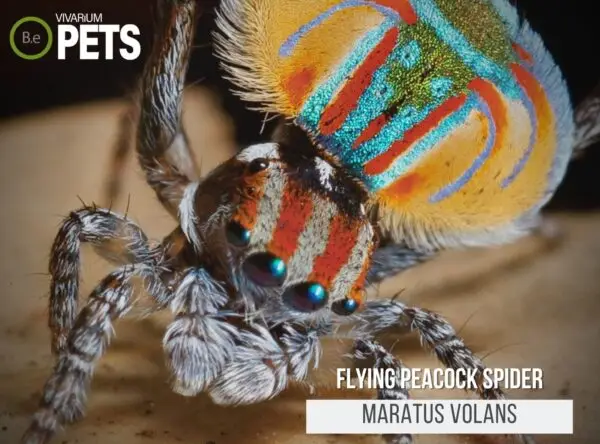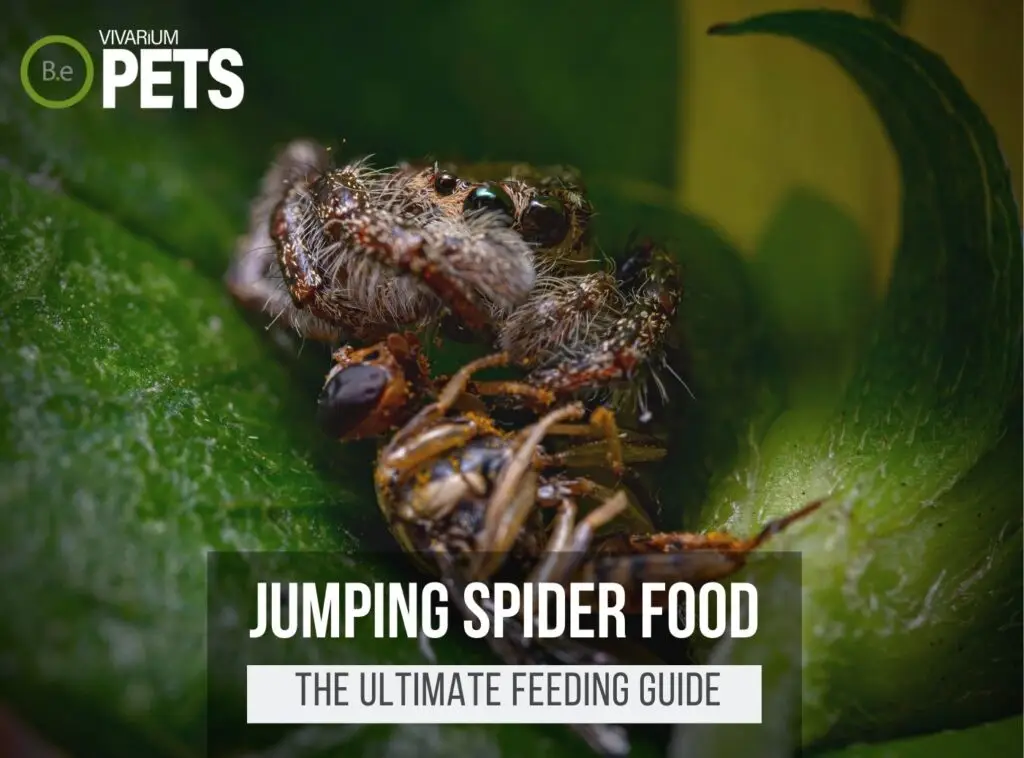To many hobbyists, Peacock Spiders are the holy grail of pet jumping spiders!
These fascinating creatures are incredibly charismatic and are extremely fulfilling to care for.
In this guide, you’ll learn how to provide Maratus volans with the best possible conditions for a long and comfortable life.
From choosing the right enclosure to maintaining a balanced diet and everyday health care, this guide will serve as your go-to resource for all things Peacock Spider.
So let’s get started and explore what it takes to provide optimal care for this flamboyant jumping spider!
Table Of Contents:
ToggleWhat Are Peacock Spiders?
The Peacock Spider is a small jumping spider from the family Salticidae, originating from the southern and eastern parts of Australia.
Due to their remarkable colors and displays, they receive the common name “Peacock Spider” from the beautiful hues and patterns of their abdomens which look strikingly similar to that of a peacock’s feathers.
Their visual displays are also an extremely important part of their courtship behavior, which males display to attract females.
These incredible little spiders also live in a variety of different habitats, including dry shrublands, grass, and tree bark.
Create the perfect home for your arachnid with our Customizable Spider Enclosure Kits, designed to meet all their habitat needs.
What Do Peacock Spiders Look Like?
Maratus volans are known for their remarkable colors and intricate patterns.
They measure between 4 to 5 millimeters in length and have a highly compacted body shape.
They have bright colors of black, orange, yellow, and blue, but the most spectacular colored features are their Dancing Flaps.
These flaps on the tip of the abdomen fan out and can be used to create amazing patterns, making them one of nature’s most beautiful wonders.
Their heads are flat and triangular, and they have large, pronounced eyes.
Several long, spindly legs extend from their body and they have two more pairs of legs underneath their head and abdomen that they can use to help with jumping and balance.
As they walk, their bodies jiggle along in an undulating fashion.
The underside of Peacock Spiders’ abdomens features a set of bristles and tufts that they can use to sense their environment.
They also have a unique set of organs that help them vibrate their abdomens.
Benefits Of Using Peacock Spiders
Using Peacock Spiders in vivariums is an excellent way to add variety and interest to your enclosure.
As active, shy, and colorful creatures, these spiders add a unique and captivating dynamic to any tank.
Not only do they make for an attractive addition to a terrarium, but also provide an undisturbed environment for your other inhabitants.
Since Peacock Spiders are small and solitary, they rarely conflict with other animals in a shared space and are generally undisturbed by the presence of other species.
Furthermore, the colorful and exotic looks of Peacock Spiders make them a great way to liven up an enclosure with some striking and eye-catching beauty!

Peacock Spider Facts
Peacock Spiders are small, vibrant arachnids found in Australia and New Zealand, boasting incredible hues and designs.
These colorful little creatures typically live up to a year and thrive on a diet of small insects and mites.
Maratus volans are generally not aggressive, making them ideal pets when handled properly, and females can lay eggs and reproduce in captivity.
Habitat
The preferred habitats of Peacock Spiders are grassy and shrubby open woodlands, which offer plenty of migratory opportunities.
These spiders often migrate annually in search of new mates and habitats.
They create burrows or retreats in ground litter and have the instinct to hide from visual predators.
As a result, they can accidentally be brought indoors in sheet litter, leaves, and logs.
They prefer warm and humid conditions, which has allowed it to spread all across Australia.
Although not widely observed yet, there are a few records of these spiders in other countries such as Singapore, where they have been increasingly spotted in recent years.
Replicate their natural habitat perfectly with our bioactive species-specific soil mixes, designed to provide the ideal moisture and organic content for your arachnids.
Diet
In the wild, Maratus volans mostly feast on small insects, such as ants and other spiders.
They will also eagerly take on decaying organic matter, such as dead insects and other tasty morsels.
When it comes to food, Peacock Spiders are very much opportunistic feeders.
In their natural habitat, they have been known to eat scavenged food such as rotting fruits and nectar.
Temperament
Peacock Spiders are generally quite gentle around humans and other animals.
They display no aggression and don’t make any sort of sound when they interact with people.
They’re quite shy and prefer to be left alone, making them a great pet for those looking for a low-maintenance companion.
Despite their shy nature, they are still fascinating creatures to observe, offering us an interesting glimpse into the world of arachnids.
In the wild, Peacock Spiders may socialize with other spiders within the same species. Males may even perform elaborate courtship displays.
These displays are usually done to attract a mate, and it can be very interesting to observe, albeit from afar.
When in captivity, however, Peacock Spiders should not be housed with other animals, as they may become stressed due to the lack of privacy.
It is also important to note that, though rare, Peacock Spiders may bite if provoked.
Lifespan
The natural lifespan of Maratus volans is typically 1 year, although they have been known to live longer in captivity.
They are a solitary species, with each spider living alone and defending its territory.
As with other spiders, the life cycle of the Peacock Spider goes through several stages of growth, starting with the egg sac and ending with the adult stage.
During the juvenile stage, the spider molts several times to shed its juvenile exoskeleton and make room for growth.
As it matures, the Peacock Spider will show signs of sexual maturity and begin to display its vibrant coloring and courtship behavior.
Breeding
Peacock Spiders have a complicated yet fascinating mating ritual.
A male Peacock Spider will first perform an elaborate dance to attract the attention of its mate.
This includes flicking its legs, displaying brightly colored abdominal appendages, and even some jumping or running.
Once a female has given the male its approval, the courtship leads to copulation.
After mating, the female will lay her eggs in clumps of leaf litter or bark crevices, and the eggs will hatch a few weeks later.
The young spiders will then disperse and begin their own independent lives.
Males reach sexual maturity within their first few months of life, while females take longer.
A single female can produce up to three egg sacs during her lifetime, each of which may contain up to 200 eggs.
Once the eggs hatch, the spiderlings go through several instar stages before molting into an adult.
Where To Find Peacock Spiders
Finding Peacock Spiders in the wild can be a little bit challenging since they are often quite small and blend into their environment.
In Australia, where they are native, you can find them amongst grasses and on tree bark in wooded areas.
In other parts of the world, such as Europe, they are often brought in as decorative items.
If you’re looking to buy a Peacock Spider, there are a few options available.
Firstly, you could visit pet shops and reptile stores in your local area.
Alternatively, you could purchase them online from reputable breeders.
Some breeders specialize only in Peacock Spiders, while others offer a variety of spiders and other arachnids.
Peacock Spider Care
Caring for Maratus volans requires providing the right enclosure and substrate, ensuring proper heating and nutrition.
It’s also good practice to be mindful of their daily health and understand their breeding and reproduction needs.
A proper care regime includes regularly observing your pet, providing adequate environmental conditions and nutrition, and being aware of the common health concerns to look out for.
Tank Requirements
The best tank for a Peacock Spider is a terrarium-style tank that allows for adequate space for the spider to roam and explore.
The ideal water provided to M. volans should have a pH of around 6.5-7.5 and a hardness range between 5-19 dH.
The overall tank temperature should range between 20-24 °C (68-85 °F).
When it comes to terrarium soil, try to use something that allows for natural burrowing such as peat moss or coco coir.
As for terrarium lighting, provides a safe and natural alternating day/night cycle.
Additionally, some ultraviolet light can be beneficial, though not necessary.
What Do Peacock Spiders Eat?
Feeding your Peacock Spider can be an enjoyable part of owning one of these unique creatures.
They are primarily insectivores and enjoy a variety of small insects and spiders as well as dried fruit and vegetation.
Here is a list of items that you can feed Maratus volans:
- Small insect larvae, such as mealworms, wax worms, and crickets.
- Dried fruit, such as apple and banana slices.
- Dried leafy greens, such as spinach and lettuce.
- Small pieces of non-toxic vegetation, such as flowers and grass.
When feeding your Peacock Spider, it is important to provide a balanced and varied diet.
You should feed your spider a variety of food items, rather than single items.
Also ensure that the food items are of appropriate size, as spiders can struggle to take down larger foods.
Lastly, you should be sure to remove uneaten food items promptly, as they can attract pests and become moldy.
Happy feeding!
If you’re looking for a more detailed approach to feeding these critters, be sure to check out my ultimate DIY jumping spider food guide. I give a more in-depth explanation of the best foods and my favorite recipe.
Best Tankmates For Peacock Spiders
When deciding which tankmates would be best for your Peacock Spider, it is important to consider if they are compatible.
Maratus volans are solitary creatures and should not be housed with other spiders or aggressive insects.
However, some small and non-threatening animals can be kept with these spiders.
Terrarium snails, for example, can be beneficial to the tank as they are natural scavengers and will help keep the enclosure clean.
Other peaceful, small animals such as isopods, springtails, and millipedes can also make great tankmates for M. volans as long as they are not large enough to pose a potential threat.
In addition to tankmates, many people find that adding plants and decor items to the tank can be beneficial for the overall health and happiness of their Peacock Jumper.
Conclusion
We hope you found this guide helpful in understanding what it takes to provide the best possible care for Maratus volans.
From choosing the right enclosure to setting up a balanced diet and regular health checks, spider care is an important part of any responsible pet owner’s repertoire.
While taking care of a Peacock Spider may seem daunting, the rewards both in terms of fun and personal satisfaction will be worth your while.
Create the ideal habitat for your arachnids with our species-specific soil mixes and Spider Enclosure Kits. These products provide everything you need for a thriving spider habitat.
Frequently Asked Questions
No, peacock spiders are not harmful to humans. They are tiny spiders known for their colorful and elaborate courtship displays, which are primarily intended to attract mates.
No, peacock spiders are not found in America. They are native to Australia and are primarily found in various regions of the country.
Peacock spiders have not been documented in any other parts of the world apart from Australia. Their unique and diverse species are specific to the Australian ecosystems.
Peacock spiders, scientifically known as Maratus, are known for their elaborate courtship displays performed by the males to attract females for mating. These displays are among the most intricate and visually stunning in the spider world.
Yes, peacock spiders are a species of jumping spiders. They can jump distances up to 40 times their own body length. They use this jumping ability to capture prey and to perform courtship displays.
No, peacock spiders do not make audible noise or produce any sounds as a part of their natural behavior.
The lifespan of a peacock spider can vary depending on the species and environmental conditions. However, in general, the lifespan of peacock spiders is relatively short. It typically ranges from several months to a year.
Yes, peacock spiders are egg–laying insects. They lay eggs in a sac that is coated in a protective liquid that dries into a hard shell.
Predators of peacock spiders include birds, lizards, frogs, and large predatory insects. They may also be eaten by spiders of other species or by larger species of spiders such as the tarantula.
The specific species name, volans, is derived from Latin and means “flying” or “to fly.” It refers to the spider’s remarkable jumping ability, as peacock spiders are known for their agile and impressive jumps during courtship displays and evasive maneuvers.







